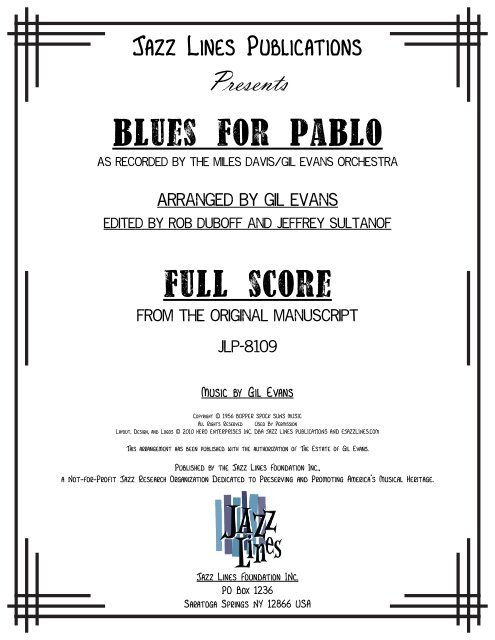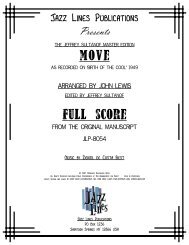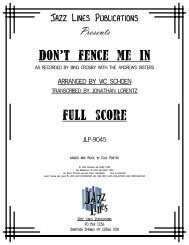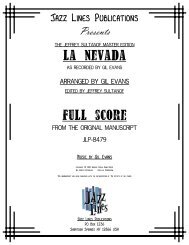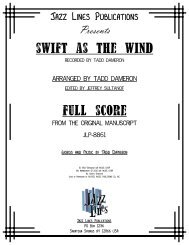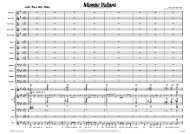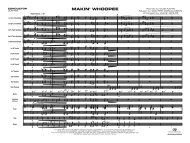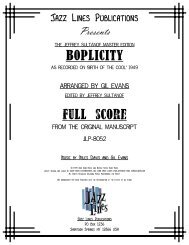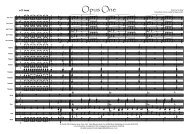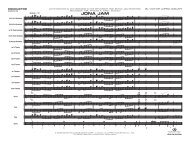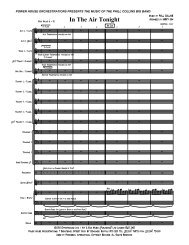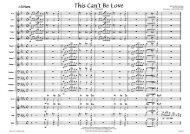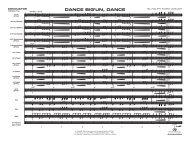Blues for Pablo - JLP-8109 - Score.MUS - Ejazzlines.com
Blues for Pablo - JLP-8109 - Score.MUS - Ejazzlines.com
Blues for Pablo - JLP-8109 - Score.MUS - Ejazzlines.com
You also want an ePaper? Increase the reach of your titles
YUMPU automatically turns print PDFs into web optimized ePapers that Google loves.
Jazz Lines Publications<br />
Presents<br />
blues <strong>for</strong> pablo<br />
As recorded by the miles davis/gil evans orchestra<br />
Arranged by gil evans<br />
edited by rob duboff and jeffrey sultanof<br />
full score<br />
from the original manuscript<br />
jlp-<strong>8109</strong><br />
Music by Gil Evans<br />
Copyright © 1956 BOPPER SPOCK SUNS <strong>MUS</strong>IC<br />
All Rights Reserved Used By Permission<br />
Layout, Design, and Logos © 2010 HERO ENTERPRISES INC. DBA JAZZ LINES PUBLICATIONS AND EJAZZLINES.COM<br />
This arrangement has been published with the authorization of The Estate of Gil Evans.<br />
Published by the Jazz Lines Foundation Inc.,<br />
a Not-<strong>for</strong>-Profit Jazz Research Organization Dedicated to Preserving and Promoting America’s Musical Heritage.<br />
Jazz Lines Foundation INc.<br />
PO Box 1236<br />
Saratoga Springs NY 12866 USA
gil evans series<br />
blues <strong>for</strong> pablo (1956)<br />
<br />
Background:<br />
Miles Davis signed with Columbia Records thanks to producer George Avakian, who heard him in per<strong>for</strong>mance at the 1955<br />
Newport Jazz Festival. By then, Miles had kicked his drug habit and was getting himself together. There was one problem:<br />
Prestige Records still had him under contract <strong>for</strong> another year and a half and recorded him extensively during that time.<br />
But Avakian began planning Miles’ recording activities the moment Davis signed his contract. It was the beginning of an<br />
association that would last over twenty years, long after other jazz artists left Columbia.<br />
Very early on, producer and artist discussed an album with a big band, and Avakian asked Davis to choose between Gunther<br />
Schuller and Gil Evans to arrange and conduct. Miles chose Evans immediately. When the album Miles Ahead was released,<br />
it made musical history. A mix of adaptations of classical music, an original by Miles and Evans, and current jazz pieces by<br />
Dave Brubeck, John Carisi and Ahmad Jamal arranged as one long suite, it helped to re-launch Evans’ career as well as Davis’<br />
own. At around this time, eleven of the Miles Davis Nonet sides were reissued, and most listeners heard Boplicity and Moon<br />
Dreams <strong>for</strong> the fi rst time. An album <strong>for</strong> Prestige called Big Stuff further solidifi ed Evans’ standing in the jazz world.<br />
The Music:<br />
<strong>Blues</strong> <strong>for</strong> <strong>Pablo</strong> was originally written <strong>for</strong> Hal McKusick <strong>for</strong> inclusion on his Jazz Workshop LP recorded in 1956 <strong>for</strong> RCA<br />
Victor Records (this album also included Jambangle, which was later re-orchestrated and expanded <strong>for</strong> Evans’ Big Stuff LP<br />
<strong>for</strong> Prestige Records). Evans mixes an idea in minor that has two infl uences (a theme from Falla’s ballet El Sombrero de<br />
Tres Picos and a Mexican folk song 1 ) with a blues in major, and the effect is pure Gil Evans. His treatment of this piece <strong>for</strong><br />
Davis’ album is identical in <strong>for</strong>m to the McKusick version, but is in a different key, and of course is set <strong>for</strong> a larger ensemble.<br />
Despite a large brass ensemble of fi ve trumpets, four trombones (including a bass trombone) and tuba, he used four reeds,<br />
of which only one was a saxophone. The other reeds are fl utes and bass clarinet. Please note that there is no piano part <strong>for</strong><br />
this arrangement, and none should be added.<br />
There have been two previous editions of this music available. The first was prepared by Joe Muccioli <strong>for</strong> various per<strong>for</strong>mances<br />
he conducted that is available from the Gil Evans estate, the second an edited and partially transcribed edition made by Steve<br />
Lajoie and published in a folio by Advance Music. This Jazzlines publication is a newly edited per<strong>for</strong>mance edition prepared<br />
from a copy of the score used by the American Jazz Orchestra. The original score was discovered in 1995, part of three<br />
boxes of music belonging to Miles that were in storage <strong>for</strong> several years.<br />
This edition hues closely to what Evans originally wrote; the corrections consist of adding clear articulation (which is often<br />
non-existent or misleading in Evans’ music) and fixing wrong notes. Don’t let anyone tell you that maestro Evans did not<br />
make mistakes in his manuscripts; he most certainly did. So an editor must look carefully to make sure that what is fi nally<br />
published is in fact what the <strong>com</strong>poser wanted. This is made easier because Evans’ voicings are based on instrumental<br />
doublings, so checking say, the bass clarinet and bass trombone against each other usually solves any note questions, as well<br />
as listening to the recording. Obviously, consultation of the original parts would be helpful to aid in this pursuit. However,<br />
they are currently unavailable.
Notes to the Conductor:<br />
Editing a Gil Evans score from the Miles Davis sessions is a challenging exercise. Despite his usage of large King Brand<br />
score paper, Evans’ handwriting is often not very clear, and fl ats and naturals sometimes look alike. Evans often uses unusual<br />
rhythmic notation as well, and despite mailing copies of the parts to the musicians be<strong>for</strong>e the sessions (and as can be seen<br />
on discographies, the musicians on these recording dates were the best in the New York music world), they had a tough<br />
time playing this music. The sessions <strong>for</strong> this album went overtime, and per<strong>for</strong>mances had to be spliced together.<br />
I once heard a conductor of this music insist that these pieces play themselves. This of course is absolute nonsense; if any<br />
music needs lots of tender loving care from the conductor to <strong>com</strong>e alive, it is this. The advantage of being able to purchase<br />
this music is the luxury of time <strong>for</strong> the conductor to study these scores carefully, and have adequate rehearsal time to<br />
fully explore the many layers of sound this music has deep within the notes. Listening to both the McKusick and Davis<br />
per<strong>for</strong>mances is a great help as well to hear how the music needs to breathe to sound right.<br />
A key issue is the treatment of the fl utes in live per<strong>for</strong>mance; obviously an alto fl ute is easily buried by all of those brass<br />
instruments, and a bit of subtle amplifi cation should be considered so the fl utes sound as the coloristic enhancement to<br />
the ensemble that Evans clearly wanted. Please do not have them louder than the trumpets; they need to be equal in sound<br />
to the section.<br />
Jeffrey Sultanof<br />
-April 2010<br />
Footnote: 1 In his liner notes <strong>for</strong> Miles Davis/Gil Evans – The Complete Columbia Recordings, Bill Kirchner cites an article by Max Harrison<br />
with this in<strong>for</strong>mation.
jlp-<strong>8109</strong><br />
<strong>Score</strong><br />
Solo Trumpet<br />
Reed 1:<br />
Alto Sax.<br />
<br />
<br />
<br />
ad lib tempo rubato<br />
On Cue<br />
<br />
<br />
{S`o`l`o`}<br />
<br />
<br />
<br />
3<br />
f<br />
blues <strong>for</strong> pablo<br />
[A]<br />
<br />
3<br />
recorded by miles davis<br />
<br />
<br />
<br />
<br />
<br />
<br />
<br />
<br />
Jazz Lines Publications<br />
Music by Gil Evans<br />
Arranged By Gil Evans<br />
Edited by Rob DuBoff and Jeffrey Sultanof<br />
<br />
<br />
<br />
<br />
<br />
<br />
3<br />
Reed 2:<br />
Flute<br />
Reed 3:<br />
Alto Flute<br />
Reed 4:<br />
Bass Clarinet<br />
Trumpet 1<br />
<br />
<br />
<br />
<br />
<br />
<br />
mp<br />
<br />
<br />
mp<br />
<br />
<br />
mp<br />
<br />
<br />
<br />
<br />
{O`p`e`n``}<br />
<br />
<br />
<br />
<br />
<br />
<br />
<br />
<br />
<br />
‘<br />
‘<br />
<br />
<br />
(3)<br />
‘<br />
(3)<br />
‘<br />
<br />
<br />
<br />
<br />
<br />
<br />
<br />
<br />
<br />
<br />
<br />
<br />
<br />
<br />
<br />
<br />
Trumpet 2<br />
<br />
{O`p`e`n``}<br />
<br />
<br />
<br />
<br />
<br />
<br />
<br />
Trumpet 3<br />
<br />
{O`p`e`n``}<br />
<br />
<br />
<br />
<br />
<br />
<br />
<br />
Trumpet 4<br />
<br />
{O`p`e`n``}<br />
<br />
<br />
<br />
<br />
<br />
<br />
<br />
Trumpet 5<br />
<br />
{T`o` ``E``x`t`e`n`d`e`d` ``H`a`r`m`o`n` `M`u`t`e`}<br />
<br />
<br />
<br />
<br />
<br />
<br />
<br />
Horn in F 1<br />
<br />
<br />
<br />
<br />
<br />
<br />
<br />
<br />
<br />
mp<br />
Horn in F 2<br />
Trombone 1<br />
<br />
<br />
<br />
<br />
<br />
mp<br />
{In` ``H`a`t``}<br />
<br />
<br />
mp<br />
<br />
<br />
<br />
<br />
<br />
<br />
<br />
<br />
<br />
<br />
<br />
<br />
Trombone 2<br />
<br />
<br />
{In` ``H`a`t``}<br />
<br />
<br />
mp<br />
<br />
<br />
<br />
<br />
<br />
<br />
Trombone 3<br />
<br />
<br />
{In` ``H`a`t``}<br />
<br />
<br />
mp<br />
<br />
<br />
<br />
<br />
<br />
<br />
Bass Trombone 4<br />
Tuba<br />
<br />
<br />
<br />
<br />
{In` ``H`a`t``}<br />
<br />
<br />
mp<br />
<br />
<br />
mp<br />
<br />
<br />
<br />
<br />
<br />
<br />
<br />
<br />
<br />
<br />
<br />
<br />
Bass<br />
<br />
<br />
{A`r`c`o`}<br />
<br />
<br />
<br />
<br />
<br />
<br />
<br />
<br />
Drum Set<br />
<br />
{T`a```m``b`o`u`r```i``n`e`````}<br />
˙æ<br />
Very Soft Tremelo<br />
˙æ<br />
˙æ<br />
˙æ<br />
<br />
˙æ<br />
<br />
1<br />
2<br />
3<br />
4<br />
5<br />
Copyright © 1956 BOPPER SPOCK SUNS <strong>MUS</strong>IC<br />
All Rights Reserved Used By Permission<br />
Layout, Design, and Logos © 2010 HERO ENTERPRISES INC. DBA JAZZ LINES PUBLICATIONS AND EJAZZLINES.COM<br />
This arrangement has been published with the authorization of The Estate of Gil Evans.
Jazz Lines Publications<br />
blues <strong>for</strong> pablo<br />
<strong>Score</strong> - Page 3<br />
jlp-<strong>8109</strong><br />
Solo Tpt.<br />
<br />
On Cue<br />
<br />
3<br />
<br />
<br />
<br />
On Cue<br />
<br />
<br />
a tempo = 60<br />
On Cue<br />
<br />
<br />
<br />
Rd. 1 (A. Sx.)<br />
<br />
<br />
<br />
<br />
<br />
<br />
<br />
<br />
<br />
Rd. 2 (Fl.)<br />
<br />
<br />
<br />
<br />
<br />
<br />
<br />
<br />
3 3 3 3<br />
mp<br />
Accel.<br />
<br />
<br />
<br />
Rit.<br />
3 3 3 3<br />
Rd. 3 (A. Fl.)<br />
Rd. 4 (Bs. Cl.)<br />
Tpt. 1<br />
<br />
<br />
<br />
<br />
<br />
<br />
<br />
<br />
<br />
<br />
<br />
<br />
<br />
<br />
p<br />
<br />
<br />
<br />
<br />
<br />
<br />
<br />
<br />
<br />
<br />
<br />
<br />
û<br />
<br />
mf<br />
<br />
<br />
<br />
mp<br />
<br />
mp<br />
<br />
<br />
<br />
3 3 3 3<br />
mp<br />
Accel.<br />
<br />
<br />
<br />
<br />
<br />
Rit.<br />
3 3 3 3<br />
Tpt. 2<br />
<br />
<br />
<br />
<br />
p<br />
<br />
<br />
û<br />
<br />
mf<br />
<br />
mp<br />
<br />
Tpt. 3<br />
Tpt. 4<br />
<br />
<br />
<br />
<br />
<br />
<br />
<br />
<br />
p<br />
p<br />
<br />
<br />
û<br />
mf<br />
<br />
<br />
û<br />
<br />
mf<br />
<br />
mp<br />
<br />
mp<br />
<br />
<br />
Tpt. 5<br />
Hn. 1<br />
<br />
<br />
<br />
<br />
<br />
<br />
<br />
<br />
<br />
<br />
<br />
<br />
<br />
mp<br />
<br />
3 3 3 3<br />
<br />
<br />
Accel.<br />
Rit.<br />
3 3 3 3<br />
<br />
<br />
<br />
<br />
mf<br />
mp<br />
Hn. 2<br />
<br />
<br />
<br />
<br />
<br />
<br />
mf<br />
<br />
mp<br />
<br />
Tbn. 1<br />
<br />
<br />
<br />
<br />
<br />
<br />
<br />
<br />
<br />
<br />
mf<br />
mp<br />
Tbn. 2<br />
<br />
<br />
<br />
<br />
<br />
<br />
<br />
<br />
<br />
mf<br />
mp<br />
Tbn. 3<br />
<br />
<br />
<br />
<br />
<br />
<br />
<br />
<br />
<br />
Bs. Tbn. 4<br />
Tuba<br />
Bass<br />
<br />
<br />
<br />
<br />
<br />
<br />
<br />
<br />
<br />
<br />
<br />
<br />
<br />
<br />
<br />
<br />
<br />
mf<br />
<br />
mf<br />
<br />
mf<br />
<br />
mf<br />
mp<br />
<br />
mp<br />
<br />
mp<br />
{P`i`z`z`}<br />
<br />
mp<br />
<br />
3<br />
<br />
<br />
<br />
<br />
<br />
3<br />
<br />
D. S.<br />
<br />
˙æ<br />
<br />
˙æ<br />
``D``r`u`m` `S`e`t```}<br />
{T`o`<br />
˙æ<br />
mf<br />
<br />
œ<br />
mp<br />
(Tom-Tom)<br />
œ<br />
<br />
œ<br />
<br />
œ<br />
<br />
‘<br />
6<br />
7<br />
8<br />
9


